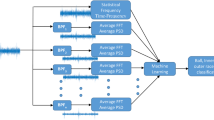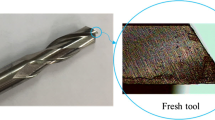Abstract
This article presents the fault diagnosis of the face milling tool using sound signal. During milling, sound signals of the face milling tool under healthy and fault conditions are acquired. Discrete wavelet transform (DWT) features are extracted from the acquired sound signals. The support vector machine (SVM) technique is used to classify the face milling tool conditions using the extracted DWT features. Also, a comparison of classification efficiencies of different classifiers with respect to different features extraction methods is carried out. It is shown that, all extracted DWT features demonstrate better results than those obtained from selected statistical features and empirical mode decomposition features. The SVM technique is the best classifier as it has given an encouraging result in this study when compared to other classifiers, and it has provided 83% classification accuracy for the given experimental conditions and workpiece of steel alloy 42CrMo4. Hence, the SVM method and DWT technique can be put forward for the applications of condition monitoring of the face milling tool with sound signal.







Similar content being viewed by others
References
Ali JB, Fnaiech N, Saidi L, Chebel-Morello B, Fnaiech F (2015) Application of empirical mode decomposition and artificial neural network for automatic bearing fault diagnosis based on vibration signals. Appl Acoust 89:16–27
Altintas Y (1992) Prediction of cutting forces and tool breakage in milling from feed drive current measurements. J Eng Ind 114(4):386–392
Amarnath M, Sugumaran V, Kumar H (2013) Exploiting sound signals for fault diagnosis of bearings using decision tree. Measurement 46(3):1250–1256
Blum AL, Langley P (1997) Selection of relevant features and examples in machine learning. Artif Intell 97(1):245–271
Chen XQ, Li HZ (2009) Development of a tool wear observer model for online tool condition monitoring and control in machining nickel-based alloys. Int J Adv Manuf Technol 45(7–8):786–800
Cleary JG, Trigg LE (1995) K*: An instance-based learner using an entropic distance measure. In: Proceedings of the 12th international conference on machine learning, vol 5, pp 108–114
Dutta S, Pal SK, Sen R (2016) On-machine tool prediction of flank wear from machined surface images using texture analyses and support vector regression. Precis Eng 43:34–42
Gangadhar N, Kumar H, Narendranath S, Sugumaran V (2014) Fault diagnosis of single point cutting tool through vibration signal using decision tree algorithm. Procedia Mater Sci 5:1434–1441
Geramifard O, Xu JX, Zhou JH, Li X (2012) A physically segmented hidden Markov model approach for continuous tool condition monitoring: diagnostics and prognostics. IEEE Trans Ind Inform 8(4):964–973
Ghosh N, Ravi YB, Patra A, Mukhopadhyay S, Paul S, Mohanty AR, Chattopadhyay AB (2007) Estimation of tool wear during CNC milling using neural network-based sensor fusion. Mech Syst Signal Process 21(1):466–479
Huang SN, Tan KK, Wong YS, De Silva CW, Goh HL, Tan WW (2007) Tool wear detection and fault diagnosis based on cutting force monitoring. Int J Mach Tools Manuf 47(3):444–451
Huang PB, Ma CC, Kuo CH (2015) A PNN self-learning tool breakage detection system in end milling operations. Appl Soft Comput 37:114–124
Huo P, Zhang M, Gao L, Li R (2014) On-line tool condition detection based on acoustic signal. Int J Appl 4(4):202–207
Jedliński Ł, Jonak J (2015) Early fault detection in gearboxes based on support vector machines and multilayer perceptron with a continuous wavelet transform. Appl Soft Comput 30:636–641
Kuljanic E, Totis G, Sortino M (2009) Development of an intelligent multisensor chatter detection system in milling. Mech Syst Signal Process 23(5):1704–1718
Kumar R, Singh M (2013) Outer race defect width measurement in taper roller bearing using discrete wavelet transform of vibration signal. Measurement 46(1):537–545
Kumar H, Kumar TA, Amarnath M, Sugumaran V (2012) Fault diagnosis of antifriction bearings through sound signals using support vector machine. J VibroEng 14(4):887
Kumar H, Kumar TR, Amarnath M, Sugumaran V (2014) Fault diagnosis of bearings through vibration signal using Bayes classifiers. Int J Comput Aided Eng Technol 6(1):14–28
Li X, Lim BS, Zhou JH, Huang S, Phua SJ, Shaw KC, Er MJ (2009) Fuzzy neural network modelling for tool wear estimation in dry milling operation. In: Annual conference of the prognostics and health management society, pp 1–11
Lu MC, Kannatey-Asibu E (2002) Analysis of sound signal generation due to flank wear in turning. J Manuf Sci E 124(4):799–808
Lu MC, Kannatey-Asibu E (2004) Flank wear and process characteristic effect on system dynamics in turning. J Manuf Sci E 126(1):131–140
Lu MC, Wan BS (2013) Study of high-frequency sound signals for tool wear monitoring in micromilling. Int J Manuf Technol 66(9–12):1785–1792
Mallat SG (1989) A theory for multiresolution signal decomposition: the wavelet representation. IEEE Trans Pattern Anal 11(7):674–693
Milfelner M, Cus F, Balic J (2005) An overview of data acquisition system for cutting force measuring and optimization in milling. J Mater Process Technol 164:1281–1288
Muralidharan V, Sugumaran V, Indira V (2014) Fault diagnosis of monoblock centrifugal pump using SVM. Int J Eng Sci Technol 17(3):152–157
Nebot JVA, Morales-Menendez R, Guevara AJV, Rodriguez CA (2006) Surface roughness and cutting tool-wear diagnosis based on Bayesian networks. Fault Detect Superv Saf Tech Process 6(1):408–413
Orhan S, Er AO, Camuşcu N, Aslan E (2007) Tool wear evaluation by vibration analysis during end milling of AISI D3 cold work tool steel with 35 HRC hardness. NDT E Int 40(2):121–126
Peng Y (2006) Empirical model decomposition based time-frequency analysis for the effective detection of tool breakage. J Manuf Sci E-T ASME 128(1):154–166
Rubio EM, Teti R (2009) Cutting parameters analysis for the development of a milling process monitoring system based on audible energy sound. J Intell Manuf 20(1):43–54
Saimurugan M, Ramachandran KI, Sugumaran V, Sakthivel NR (2011) Multi component fault diagnosis of rotational mechanical system based on decision tree and support vector machine. Expert Syst Appl 38(4):3819–3826
Salgado DR, Alonso FJ (2007) An approach based on current and sound signals for in-process tool wear monitoring. Int J Mach Tools Manuf 47(14):2140–2152
Shao H, Wang HL, Zhao XM (2004) A cutting power model for tool wear monitoring in milling. Int J Mach Tools Manuf 44(14):1503–1509
Shi X, Wang R, Chen Q, Shao H (2015) Cutting sound signal processing for tool breakage detection in face milling based on empirical mode decomposition and independent component analysis. J Vib Control 21(16):3348–3358
Sivanandam SN, Deepa SN (2006) Introduction to neural networks using Matlab 6.0. Tata McGraw-Hill Education, New Delhi
Tobon-Mejia DA, Medjaher K, Zerhouni N (2012) CNC machine tool’s wear diagnostic and prognostic by using dynamic Bayesian networks. Mech Syst Signal Process 28:167–182
Vernekar K, Kumar H, Gangadharan KV (2014) Fault diagnosis of deep groove ball bearing through discrete wavelet features using support vector machine. Cond Monit Diagn Eng Manag 17:31–37
Vernekar K, Kumar H, Gangadharan KV (2015) Fault diagnosis of gears through discrete wavelet features based on a decision tree and support vector machine. Int J Cond Monit 5(2):23–29
Widodo A, Yang BS (2007) Support vector machine in machine condition monitoring and fault diagnosis. Mech Syst Signal Process 21(6):2560–2574
Yan R, Gao RX, Chen X (2014) Wavelets for fault diagnosis of rotary machines: a review with applications. Signal Process 96:1–15
Zhou JH, Pang CK, Zhong ZW, Lewis FL (2011) Tool wear monitoring using acoustic emissions by dominant-feature identification. IEEE Trans Instrum Meas 60(2):547–559
Acknowledgement
The author/s acknowledge the contribution of Centre for System Design (CSD): A Centre of Excellence at NITK Surathkal pertaining to issuance of technical equipment/product service/experimental facility. The technical support received from the members of SOLVE: The Virtual Lab at NITK Surathkal is deeply appreciated. The authors also acknowledge help rendered by Dr. V. Sugumaran, Associate Professor, VIT University, Chennai.
Author information
Authors and Affiliations
Corresponding author
Rights and permissions
About this article
Cite this article
Madhusudana, C.K., Kumar, H. & Narendranath, S. Face milling tool condition monitoring using sound signal. Int J Syst Assur Eng Manag 8 (Suppl 2), 1643–1653 (2017). https://doi.org/10.1007/s13198-017-0637-1
Received:
Revised:
Published:
Issue Date:
DOI: https://doi.org/10.1007/s13198-017-0637-1




